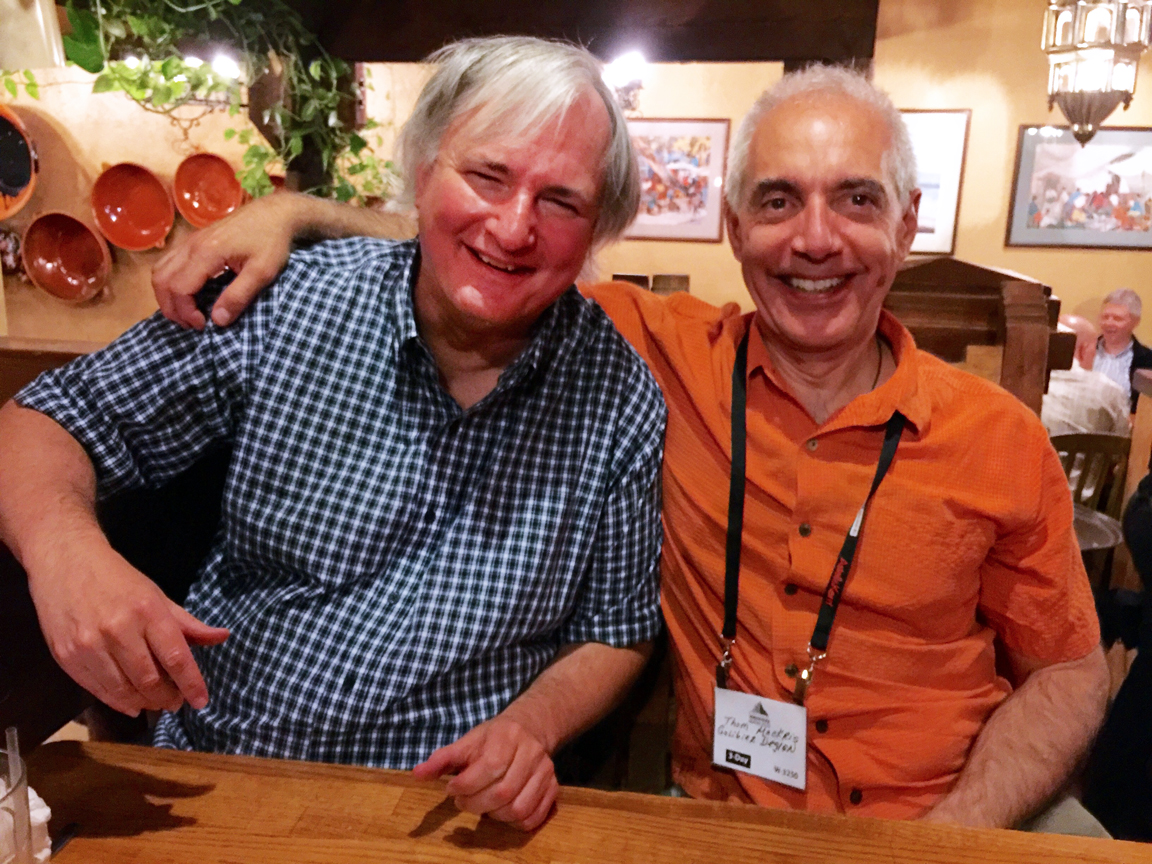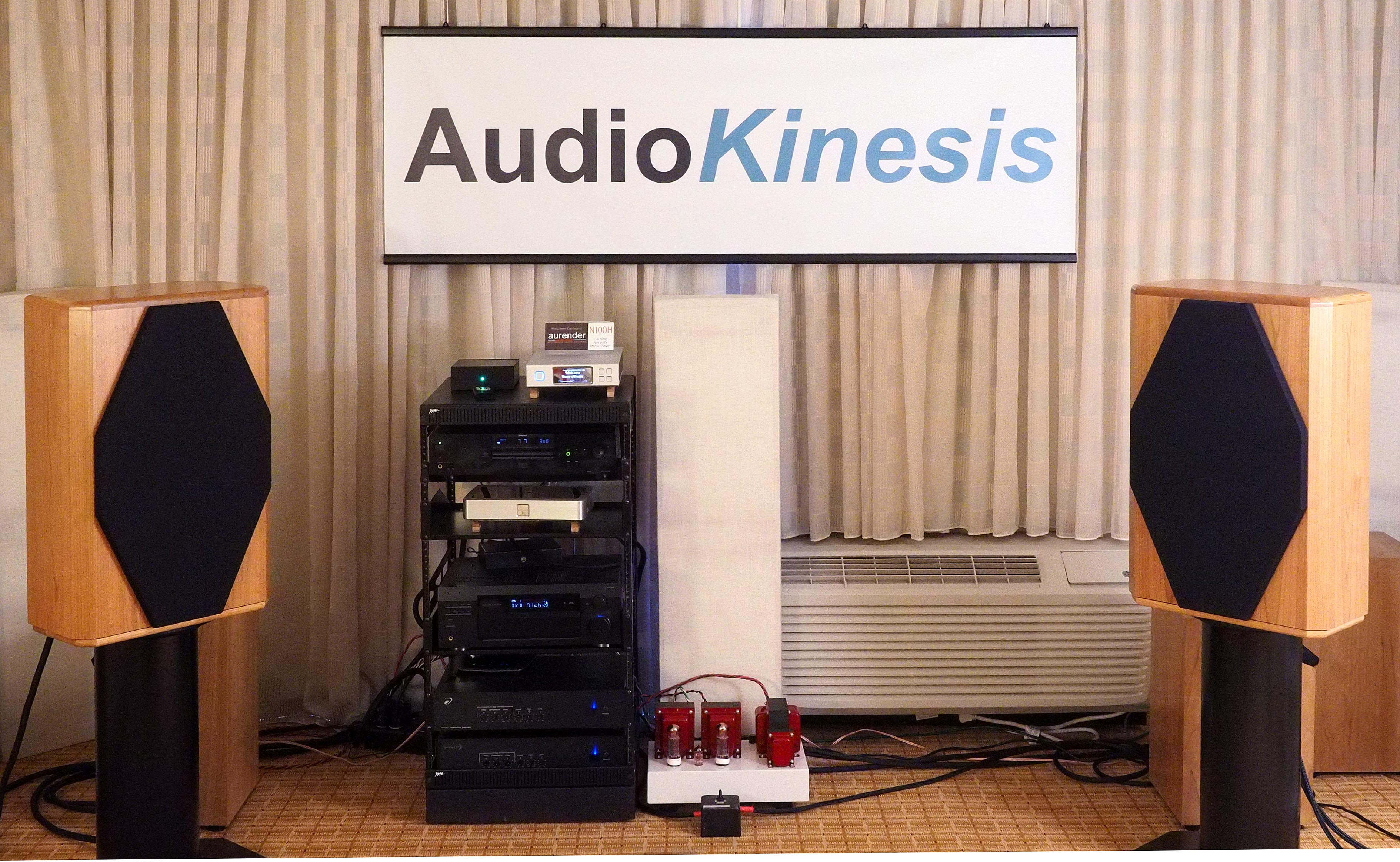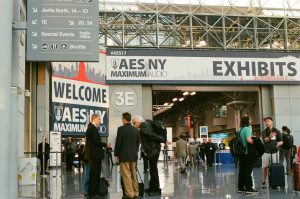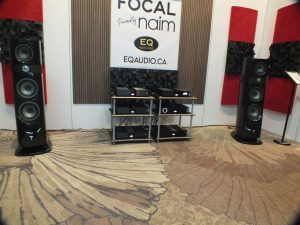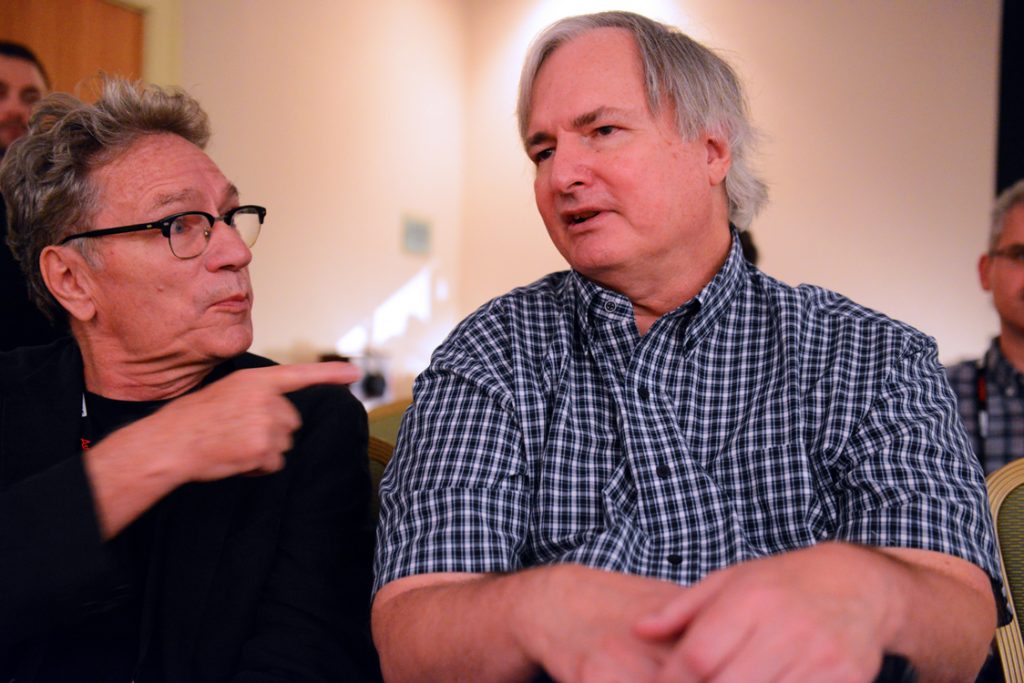
Herb Reichert and Lynn Olson at RMAF 2015 (photograph and image processing by David W. Robinson)
As my readers know, my usual beat is high-efficiency speakers, triode amplifiers, and surround sound (which was my start in the audio industry). So, this part of the show report is a part of the RMAF I don't usually cover … solid-state and standard-efficiency speakers. I'm not in the slightest interested in the mainstream Krell/Wilson/Magico part of the industry… let others cover that, I don't go there. Not my kind of sound.
But… every now and then I hear things at the RMAF that are not part of the audio mainstream, and have exceptional qualities, regardless of technology. This time, I heard the Prana Fidelity room, and it was really, really good. The speakers were internally tri-amplified, and were custom EQ'ed to the room. "Why, that's cheating! You can't do that! You can't room-match the speakers at a hifi show!"
Well, yes, you can, if the price includes Steve Norbert personally visiting your home and giving YOU the equalization curve you like best in your listening space. This isn't the awful Audyssey system that every home-theater receiver includes (which I do not use in my HT setup), but custom EQ dialed-in for your tastes… flat, slight warmth, whatever you like. And it's not DSP as far as I could tell, but good old-fashioned analog EQ as an integral part of the electronic crossover, where it belongs. My listening session told me that unlike the other rooms, these speakers really were flat, and not plagued with the heavy bass boom that was afflicting the other rooms. More importantly, the driver selection all represented top-of-the-line drivers, which makes the EQ and crossover tasks much simpler. (I can say from experience it is NOT fun trying to equalize drivers with wacky frequency responses… this is especially difficult with high-efficiency drivers with peaky responses.)
The internal amps were well-chosen as well, free of solid-state grain or harshness, but not syrupy-sounding, either (the two main faults of solid-state sound). The result was a speaker that has outstanding dynamics (thanks to tri-amping), vivid tone colors, but almost no driver coloration at all. Kind of like an electrostat, but much wider dynamic swings, and deeper, richer tone colors. One of the best self-amplified speakers I've heard to date… maybe even the best so far. If I heard the price correctly, it was $30,000/pair, which is a chunk of change, but then again, that includes 3 amps per side that are really good, an electronic crossover that is free of the usual opamp colorations, and a personal visit from the designer so it matches your listening space. In that light, maybe not so expensive after all, since the rest of the system is nothing but a linestage and signal sources… for that matter, one of the modern DAC/streamers with an internal linestage, which gets the entire system down to one box and two speakers.
I'm not usually a big fan of the solid-state world, but this system had no solid-state character at all, and did not have the fake-tube "warmth" that sounds like a plug-in for a digital workstation. There was a hint of BBC-monitor or Quad ESL sweetness, which is fine by me, and worlds away from the etched diamond-hardness of much of the rest of the show. But wasn't any lack of detail; it just sounded realistic, in-the-room, with a strong "live sound" quality to it. I usually associate this "live-sound" quality with high efficiency, but I think the tri-amping and skillful equalization is doing the heavy lifting here (along with really good drivers). Anyway, if you're open-minded enough to consider a self-amplified speaker, I'd go out of my way and find a dealer that will give you a listen. This one is special.
Speaking of special, naturally I had to visit the Vaughn/Wavelength room, featuring the famous Ionovac ionic tweeter. The Zinfandel Line Array they were showing was more to my taste than what they were showing last year, and this time around, they got the mids to match the speed of the ionic tweeter. That's not as easy as it sounds, because an ionic tweeter is basically massless and has no overhang at all. This makes finding a matching midrange really difficult, because driver mismatch really stands out when drivers are on this level of quality. I frankly didn't envy them for the task they had to do … it borders on near-impossible, and is the downfall of nearly every other commercial speaker with an exotic tweeter. The famous (or notorious) Plasmatronics I heard back in the late Seventies at the CES was pretty spectacular with its built-in helium tank and a primary designer who had a day job at Los Alamos, but it was also let down by a very mundane paper-cone midrange. The treble, though, was out-of-this-world in dynamics and sheer transient speed… basically no speaker at all when you heard woodblocks and other percussion instruments.
Does the newly revived Ionovac sound like the Plasmatronics? Wow, that's hard to say. That's really pressing my acoustic memory to the limits, and besides, the sound source back then was a something like a Linn LP12 turntable with a moving-coil cartridge (that was pre-digital). Sources, including analog, have gone a long way since then. And midranges in particular are far better now, although the modern crop tend to use cones made from exotic materials with high-Q ringing modes. The Plasmatronics also preceded the early-Nineties triode revival, so the overall sonic balance was different.
Despite what you might think based on the physics of the Ionovac, the first impression was not speed, speed, speed (although that was certainly there, waiting in reserve for the right transient). Mostly, it was very relaxed and natural, nothing like the somewhat nervous sound of an electrostatic headphones. There was faster-than-electrostat speed on occasion, but it also made you aware that electrostats, fast as they are, have their own distinct coloration. Which is another way of saying that ALL speaker technologies have their own distinctive sound, and I'm not sure if any are truly neutral, compared to live music. But some have less coloration than others, and what coloration that remains is agreeable and consonant with musical values. This, by the way, is my gripe with the sound of mainstream high-end audio. Coloration levels vary, but the colorations I hear in many rooms are grossly unmusical and electronic-sounding. Which is OK for EDM, techno, and whatnot, but completely destroys the fabric of acoustic music and replaces it with metal and steel. If I'm going to hear coloration (and this is unavoidable at the current state of the art), I'd rather hear something that sounds like music, thank you very much. Getting back to the Vaughn/Wavelengthe room... the sound was both relaxed and effortless, and completely free of the edgy brittleness of most of the rest of the show. Oh yes, and really, really fast, when called for. That's the mass-less tweeter, of course.
To sum up, the memorable rooms this year were Klipsch, debuting their new Cornwall IV, which is a major step forward for the Klipsch company. Modern crossover technology, allied with new low-diffraction horn profiles and diaphragm materials, have made the Cornwall IV's one of the best high-efficiency speakers out there, with coloration levels as low as good audiophile speakers, with far greater dynamics and vivid tone colors thrown in for free. Well, not quite free, but mighty competitive at the $6000/pair price.
The Prana Fidelity and Vaughn/Wavelength rooms were also really impressive in their own right, and sounded outstanding in a brand-new hotel environment that was giving fits to the other exhibitors. Although all three systems were selling at what are serious high-end prices, I have to honestly say they all represented outstanding value at their price point, so I must give all three a Best of Show… for sonics, technological advancements, and overall musical value.
P.S. Yes, I'm working on the exaSound e38 Mark II review. I can say right now this is a one-a-kind product with outstanding musical values, state-of-the-art measurements, and remarkable versatility, covering ALL the bases… stereo, multi-channel, PCM, DSD, you name it. And covering them very well, with no glitches, switching transitions, or other digital gremlins.
More to come.





